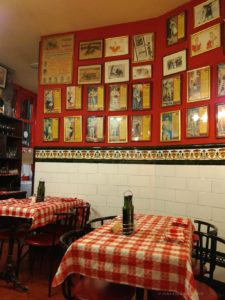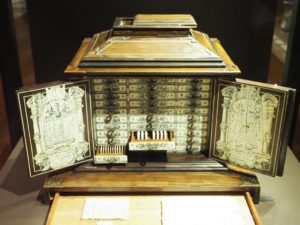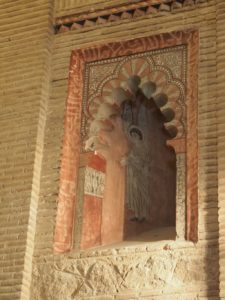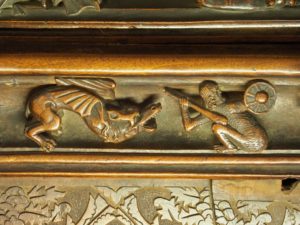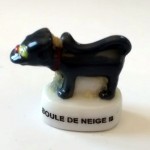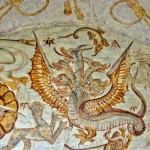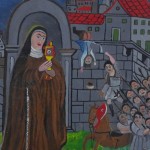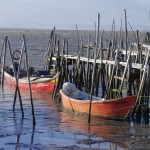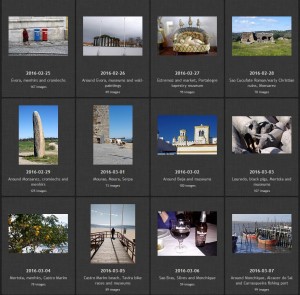To download a printable PDF version (no pictures)
click on this link E2E2018no1.pdf (seven A4 pages)
There is a comprehensive set of photographs:
Spain Feb-Mar 2018 Madrid, Toledo and Malaga
as well as links in the text
Ours is a loo with a view. Most houses have textured glass obscuring the view from their bathroom windows, but not ours. When we began converting the hayloft here, the layout allowed for a spacious bathroom which was at the time lit by a small square hole under the eaves. As the hole was surrounded by traditional pink sandstone slabs, Helen was initially reluctant to change the facade. But as the project took shape, the bathroom felt cell-like, so a window to match the others was added. It is one of only two which look north across the road to a field that climbs up to the woods. Pedestrians and motorists pass too low to see into the bathroom, so it is clear-glazed. In the early days the occasional cow grazing on the field would lift its head and gaze blankly across, and we would pull down the blind during the annual grass cutting, turning and baling. But this January we gazed with growing horror from our bathroom window.
On the very morning we were leaving for Christmas in the UK, we woke early to complete darkness. High winds throughout the night had caused a power cut. It is surprising how much light our metal shutters keep out and how much the various electrical equipment LED lights usually provide. We went back to bed until daylight. Power returned at 8.30. But downstairs we found that the first barn was flooded with muddy water. John cleared as much as he could while I left messages at the Mairie and with our neighbour. We eventually set out for family and friends around 10.00. Teaming rain caught up with us at St Quentin, and the ferries were delayed by at least two hours.
We should have been prepared for trouble on our return nearly four weeks later, as the day had started at the Dover Premier Inn with the fire alarm forcing us outside into the bitter wind during breakfast. Although only a grill fire, it was a warning. The petrol pumps in Calais were not working, the fields of northern France were water-logged or flooded, and we later discovered that high winds had brought trees in the forests round Entre-deux-Eaux over New Year, but Helen’s diary records tersely, “First barn very wet and muddy. Nothing done.” The car tyres had a high-water mud mark at 8cm.
What did we hope would have been done? In our early days here, farmer Duhaut grazed his cows on the field opposite for part of the year, and the thick grass roots knotted the soil and held it securely. There was a firm bank down to the road and a ditch that was regularly cleared by the commune employee and digger and a drainage pipe under the road into the lower field. In recent years, the new farmer has ploughed the field right up to the edge of the bank and sown maize as a summer crop and different winter crops. At the beginning of this winter the field had been freshly ploughed and sown with what might be winter wheat, but it has struggled so much in the heavy rains and with black crows pecking busily that it is difficult to be certain what crop is poking tentatively and patchily through. And this was the fine earth that was being washed down by heavy rains, silting up the ditch, continuing across the road, filling up our own small drainage channel along the front of the house and coming to a halt in our barn. The least that now-mayor Duhaut could do was to order ditch and drain clearing to be re-instated.
Mayor Duhaut would be busy, we knew, preparing his New Year Voeux to his community and the council’s festive lunch for its elderly. Nevertheless Helen went and harangued him. His wife was sympathetic when Helen mentioned the washing machine standing in mud, while he regretted the wine store, but… Well, it needed higher Road Authorities who he would contact for a permanent solution… and the commune employee had been on holiday over Christmas… Well, it was too wet at present… But of course Something Would Be Done.
On Friday evening we all trooped down to the Salle Polyvalente for the Voeux (champagne, speeches and not such good nibbles as previous years). Our neighbour had also complained that day. The commune employee (the mayor’s cousin) promised to bring his tractor and trailer when the snow and rains were over.
On Sunday we sat down promptly at 12.00 for the Mayor and council’s lunch, which started with a plum or peach aperitif, proceeded to a plate of delicious fish and meat nibbles and considerably later to a large plate of Terre et Mer, tasty and well presented. It was all prepared by Stephane, a young man in the village, and the band which struck up between courses is also local. With serious dancing between courses, there was plenty of time for Helen to slip home (between the filet de biche en croute and the large plate of cheese and salad) and bring in our washing. After the cheese, the music and dancing become more frivolous, recalling Spanish coach holidays of yesteryear, and Castanet Man unfortunately could not resist getting out his castanets and showing off annoyingly close to us just as a neighbour was trying to educate us in champagne appreciation. Castanet Man is small and unsmiling and danced with a cold precision; his wife slipped out frequently – presumably for a smoke, but possibly just for a few moments peace; alone, he danced the Madison (no cowboy hat, but fists clenched) with the focussed intensity of a heartless killer. The trou a la poire, a sorbet with locally distilled firewater poured over it, was a worthy dessert and we could later relax over coffee.
By Tuesday it was time for the next feasting – the AGM cunningly followed by lunch of the Vie du Bon Cote, as the club of the anciens is officially called. This came after a windy night and a forecast of heavier rain, and just before we left, the barn started to flood again, despite John having cleared our drainage channel and laid a barricade of bricks in front of the barn door. As the mayor and the commune employee were both on the doorstep of the Polyvalente, John showed photos from a few minutes earlier, and while we sat down to eat, two men and a digger finally set to work to clear the ditch and drain. It has to be said that they made a very good job of scooping lorry-loads of mud from both ditch and pipe, and even hosing down our house walls after.
All these days, we had been watching from the bathroom window as the water pools on the field began to make channels and tunnels through the loose soil towards the bank, and now it began to pour into the ditch like mini-waterfalls. Our neighbours commented on the sound of the cascades when they walked up to see us one wet evening. They also commented on walking the plank like pirates across our barn where the mud hadn’t dried out!. But at least the water was flowing rapidly along the cleared ditch and through the drainage pipe. So the question is… will the commune keep the ditch clear? It is filling up rapidly as dreary weather continues to wash down soil.
We probably lost your sympathy some time ago, as the UK has been undergoing its own harsh weather and transport chaos. But if you have read so far, you may understand our mid-February desire to escape from the rain and mud for a few days, and our decision to fly to Madrid for a bit of mid-winter culture.
Successful holidays depend considerably on good weather, good accommodation and good food and we were fortunate with two out of three. Although temperatures were cold, the Madrid sun shone on us. And our room at 60 Balconies was spacious, tasteful and well equipped, and enjoyed two of the sixty balconies (too small to use but the French windows had a view of the traffic racing round Emperador Carlos V and of the old railway station). With a coffee maker, cooker and fridge we could retreat “home” and put our feet up for an hour or two whenever they got too tired. We could also enjoy breakfast in bed while planning our days.
Sadly the restaurants were all very geared up to tourists, as we were almost in the shadow of the Reina Sofia museum and close to the Prado. But how can you complain about tourists when you are one yourself? The first afternoon we allowed our street wanderings to be guided by the Lonely Planet initially, so saw the Opera, Palace, Arab Wall fragment, picturesque plazas and buildings and a trendy market before launching off down more quirky back streets.
The first morning was freezing as we stepped out on our balconies to wind up the slatted shutters, but by the time we were walking up to the Thyssen-Bornemisza Museum it was pleasantly sunny. We spent most of the day there enjoying the Dutch interiors and landscapes, American painters we knew nothing about, less-frequently reproduced Impressionists, coffee, sandwiches post Impressionists, beer, crisps, Canaletto and Cubists. In the evening it was red check table cloths, posters of bull fighters and an eleven euro menu (asparagus, swordfish, garlic, chips, rice pudding) off the tourist trail.
The second day’s tourism started at the Prado, where oiks like us can rapidly become glazed by fleshy Rubens, full-skirted Velasquez, agonised El-Grecos and black Goyas. But we did enjoy the Bosch Earthly Delights, the Durers and some unexpected reconstructed Romanesque chapels and frescoes and a small room of golden 14th century church art.
And later when we eventually located the unsignposted Archaeological Museum (clue: behind, but inaccessible from, the National Library) we enjoyed its bringing together of things we had learned at different times in Spain and Portugal.
By the time our concentration (and John’s knees) were failing, we still managed to walk back across the huge Retiro Park and admire its fountains, lake, Velasquez Palace and Crystal Palace.
The Cubists at the Reina Sofia kept us occupied the next morning – all those Juan Gris and lots of artists who were new to us. Helen was reading C. J. Sansome’s Winter in Madrid, part of which is set during the Civil War, so found the Civil War section of the gallery leading to Picasso’s Guernica of particular interest.
The modern section on the top floor was less to our taste, so we rounded off our visit in the Dalis, bought some sandwiches, and rested our feet and sipped coffee in our pleasant room. We started our afternoon wanderings from the Puerto del Sol (I wonder if all those FC Copenhagen supporters watchfully corralled in one corner of the Plaza Mayor had a good result that evening), and headed south and east, just following our noses down interesting looking streets, which was how we came across a ruined church building which looked as if it had been renovated inside and lined with books, so of course Helen had to go in and find out more. It turned out to be a “Pious School” of UNED (National University of Distance Learning) Madrid, founded in 1729, looted and burnt down in the Civil War and rehabilitated in 1999. Such a shame that we couldn’t see inside the library as it was closed “for a long time” whatever that meant.
You might have noticed that another of our enthusiasms is trains. So the next day we added a short Spanish train journey and two special stations to our experiences. We walked through the old arched Atocha railway station opposite our room. No trace of rails or platforms. But dense with dusty palms and falling branches (they were being pruned though not dusted) and a green pond crawling with black turtles. Our modern train took us to the less modern Toledo station. Imagine Pugin let loose on a provincial station, with clock tower, turreted gables, Gothic windows, stained glass, coloured tiles, polished dark woodwork ticket office and Moorish archways in brick and stone.
And it was the intricate Moorish brickwork of an old mosque dating from 999 that took our breath away (having re-gained it after lugging our cases up the extremely long but broken escalator to the hill-top town centre).Even the Arabic inscription was in brickwork. Inside,the mosque was small and delicate(nothing like Cordoba’s grand forest of columns). The Christians who later reconquered the city used it as the nave of a small church, adding an apse with matching Moorish arches. It still has fragments of paintings, – the usual Christ in Majesty on the dome, the four evangelists and some saints; but have you ever seen painted angels bearing a soul to heaven in a hammock? Although it was at the bottom of a street leading down to one of the old gateways, the view from the gardens was panoramic.
Our room on the top floor of Antidoto, an old converted corner house with modern art decor, seemed very compact after our spacious Madrid room, but once we had borrowed some larger cups it had everything we needed for relaxing, and was close to the main Zocodover Square and for exploring the old town.
After a rest, we walked down narrow cobbled streets with overhanging balconies, old churches, intricate Moorish arches and windows and studded wooden doors with interesting knockers to San Roman Church, which now houses the Visigoth Museum. It contains artefacts from the 6th to 8th centuries and is covered in beautiful Romanesque frescoes from the 13th century. There seemed to have been a Visigoth 7th century church originally, which was subsequently used as a mosque, and there were still both Arabic and Latin inscriptions. The frescoes included a splendid dragon, wonderful angels and the dead tentatively lifting their tomb lids at the end of time.
The next day we spent longer than expected in the Cathedral, partly due to the good commentary on the headphones. The nave was blocked off for an exhibition and the chapter house was closed.
But we spent a long time looking at the misericords and carvings in the choir and the frescoes in the chapel of St Blaise. The Moor who is said to have stopped his fellows from attacking the Christians as they reclaimed the mosque is commemorated in a gold statue surprisingly close to the huge Gothic golden altarpiece. After the Christians had reclaimed the great mosque site, the building we visited next became the Great Mosque and later the Iglesia del Salvador. It is now a serene and attractive mixture of Islamic and Christian architecture (including a Visigoth pillar) and outside can be seen the floor of the 9th century mosque, an arcade of three columns with Roman and Visigoth capitals and some old Christian graves.
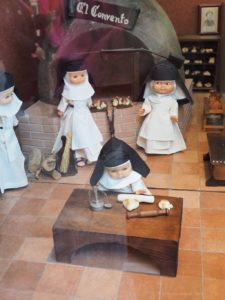 In a the window of a cafe opposite were dolls dressed as Dominican nuns demonstrating all the stages of marzipan making. It seemed a good place to sample the famous Toledo marzipan in tart form. In fact every convent we passed, whatever its denomination, seemed to offer marzipan for sale. Our tart was rich and delicious. Fortified we walked up to the Alcazar (a disappointing building), admired the view, and decided to go into the Santa Cruz Museum on the way back. It was housed in a beautiful building, with a permanent collection in the main part, a quirky exhibition of flea-market objects of yesteryear in a darkened room at the end of a lot of corridors on the first floor, a more classical room of Joaquim Sorolla landscapes, and a self-image-obsessed exhibition of the Mexican Alfredo Castaneda. That evening we ate in the basement of a busy bar near our room, and chose the menu of the mountains. The starters of Mantega cheese, pheasant pate and fish croquettes were followed by a partridge risotto and by venison in mushroom sauce. And the dessert was marzipan sponge. Could we really manage more rich marzipan? We could. As we emerged, a group of young men in black doublets and hose with yellow slashed jerkins or sashes were drinking in the bar and more were harmonizing and playing tunefully outside. One sash said Medicine. Were they medical students?
In a the window of a cafe opposite were dolls dressed as Dominican nuns demonstrating all the stages of marzipan making. It seemed a good place to sample the famous Toledo marzipan in tart form. In fact every convent we passed, whatever its denomination, seemed to offer marzipan for sale. Our tart was rich and delicious. Fortified we walked up to the Alcazar (a disappointing building), admired the view, and decided to go into the Santa Cruz Museum on the way back. It was housed in a beautiful building, with a permanent collection in the main part, a quirky exhibition of flea-market objects of yesteryear in a darkened room at the end of a lot of corridors on the first floor, a more classical room of Joaquim Sorolla landscapes, and a self-image-obsessed exhibition of the Mexican Alfredo Castaneda. That evening we ate in the basement of a busy bar near our room, and chose the menu of the mountains. The starters of Mantega cheese, pheasant pate and fish croquettes were followed by a partridge risotto and by venison in mushroom sauce. And the dessert was marzipan sponge. Could we really manage more rich marzipan? We could. As we emerged, a group of young men in black doublets and hose with yellow slashed jerkins or sashes were drinking in the bar and more were harmonizing and playing tunefully outside. One sash said Medicine. Were they medical students?
On Sunday, our last day in Toledo, we headed for the former Jewish quarter and the El Transito Synagogue, an austere and beautiful mid 14th century lofty rectangular hall with an intricate wooden ceiling, decorative moulded plaster friezes and screens and more Moorish arches. From the museum and headphones we slowly built up a picture of a respected, integrated community of Sephardic Jews who were abruptly expelled under Ferdinand and Isabella (a decree that was not revoked until the 1860s, when those who could prove their origins were granted citizenship once more). Interestingly, there was a sumptuously illustrated Bible there which a Christian had asked a Jew to write as the Jews had a less corrupt text.
From there we walked down to the even more beautiful restored Sinagoga de Santa Maria la Blanca with its five naves divided by horseshoe Moorish arches, its walls and columns a gleaming white and with intricate plaster decorations including huge pine cones. We also walked down to the river and old San Martin bridge.
We were sad to leave the rich mix of Jewish, Muslim and Christian cultures of old Toledo the next day. And even sorrier once we reached Malaga, where we had hoped to round off with a few days of sunshine and lazing around on a balcony close to the sea. It has to be said that the high speed train journey between Madrid and Malaga was agreeable, with a lunch box and drinks included in the ticket price. And there was a convenient bus from the station almost to the end of our road. But on the street outside the given number, we hesitated. It seemed to be an office block, with business plates for solicitors and no mention of accommodation. A phone call resulted in broken English instructions to number 3 on the seventh floor where her partner would be waiting. The unlabelled door was opened by a tall man of North African appearance who had a rucksack on the sofa, which all looked a bit casual. He spoke no English and we spoke no Spanish. In its favour the flat was spacious, with a large sitting room containing a sofa, wooden chair, TV and palm plant but no rug or carpet, and it had a dining room, three bedrooms, kitchen, bathroom and loo, but its furnishings and flimsy curtains did seem sparse. Then he mimed the question of whether we were paying cash or by machine. But we have already paid, we protested, producing printed proof. A long phone conversation with the woman-on-the-end-of-the-phone ensued, and although it was never conceded that we had paid, with promises of phoning back the next day, the young man gave up and went away. All a bit unsettling. We went for a stroll round and a drink until the rain started. Back at the flat, we watched the sky darken over the rooftops. We ate at the nearby small North African restaurant.
By next morning, Helen’s cold has worsened, like the weather. Umbrellas were up as we set out for the Picasso Museum, whose permanent collection was disappointing, though a temporary exhibition about Fellini’s dreams of meeting Picasso was interesting. The weather was a bit wet for imagining performances in the Roman amphitheatre’s puddles, and the Alcazaba above looked windswept. But we did later enjoy the temporary exhibition at the Centre of Contemporary Art of Malaga of carved figures of men and women by Stephan Balkenhol, Professor of Sculpture at Karlsruhe,.
The next day was also wet and we caught a bus to the renovated tobacco factory which houses the Collection of Saint Petersburg Russian Museum. Its huge white walls make for brilliant hanging spaces for the large propaganda paintings of the Radiant Future Socialist Realism in Art.
Both Stalin and Lenin looked imposing alone in front of the sea, and there were powerful paintings of industries and collective agriculture. Then we moved back a century to the Traveller’s Gaze exhibition of Russian artists’ impressions of Egypt, Morocco, Italy, Spain, America, Tibet and China. Sitting in the museum’s cafe, Helen was intrigued by three cartoon-like men; two stereotype Russian heavies approached by what in Tintin would be the obvious Russian spy or scientist working on a top-secret project (small, thin, straight up and down, brown gaberdine, glasses and a wooden expression – but no rolled newspaper or umbrella).
It poured with rain all night. We debated between the Carmen Thyssen-Bornemisza and the Pompidou as shelters, but the Thyssen was closer. It too was disappointing after Madrid’s. So we headed for the Museum of Malaga, stopping off to enjoy the Malaga portrait painter Revello de Toro in an attractive old house. Suddenly the sun came out, so we detoured up to the remains of the Alcazaba. The views from it across the port-marina were our first sight of blue sea and well worth the climb, though the rooms had none of the splendour of Granada’s heavily restored Alhambra. As the labels were all in Spanish, it was helpful to descend as the rain clouds gathered again to the archaeology floor of the Museum of Malaga, which was excellent and well labelled.
The next morning we left the apartment key on the table and caught an early bus to the airport. We had really enjoyed Madrid and Toledo, but not Malaga. We had read reports of snow closing airports in the south of France, but our flight was on time, and although we emerged at Basel airport into snowflakes and decided to take the tunnel under the Vosges, there was no snow on our side of the Vosges.
You will be relieved to know that there was also no further mud and water in our barns. The main interest as we look out of the bathroom window now is whether boars have been digging in the field each night this week, as each morning it looks more ravaged. Yesterday, after Helen had mentioned the possibility to the mayor’s secretary, a large pile of cow-shed dung was deposited at the top of the field while we were out at the Amnesty Book Sale. Is it the odour of that or the overnight snowfall which led to the field remaining undisturbed last night? (Perhaps boars do not like getting cold paws). And what will happen while we are away in the UK over Easter?


